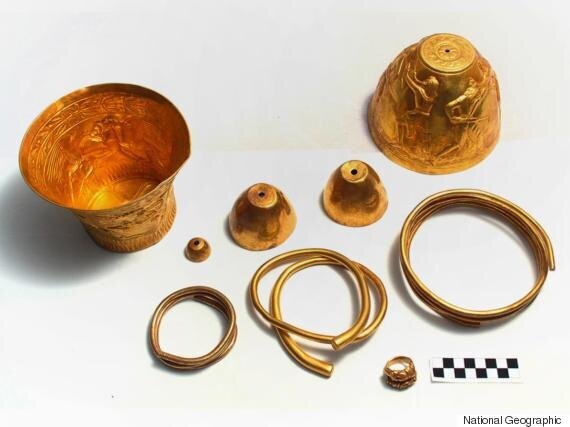A cache of intriguing gold treasures has been unearthed in the Caucasus Mountains of southern Russia.
The haul is made up of two bucket-shaped gold vessels – understood to be bongs - three cups, a heavy gold finger ring, two neck rings and a gold bracelet and dates back 2,400 years to the era of the Scythians.
This nomadic tribe, originally of Iranian stock, headed an ancient kingdom north of the Black Sea in a region now inside Ukraine and Russia.

The treasures were found in 2013 but they have only been revealed now so as to protect them from looters
The drug habits of the Scythians have been referenced as early as 430 BC by the Greek Historian Herodotus – but the splendour of their hallucinogenic rituals has never been so evident.
Anton Gass, an archaeologist at the Prussian Cultural Heritage Foundation in Berlin, described it as a “once in a century discovery.”
Speaking to National Geographic, he added: “These are among the finest objects we know from the region.”

Greek historian Herodotus wrote about the Scythians after visiting their kingdom in 430BC
Archaeologist Andrei Belinski asked criminologists in nearby Stavropol to analyse a black residue coating the inside of the vessels, revealing them to be: “Positive for opium and cannabis.”
According to the BBC, hemp was introduced to northern Europe by the Scythians in 500BC.
Remains of a double burial traced to this time yielded a decorated leather pouch containing wild cannabis seeds and between 700-300BC Scythians left cannabis seeds as offerings in royal tombs. By 1500 cannabis was being cultivated and used to weave fine hemp cloth.
SEE ALSO:
Of the tribe's predilection for smoking cannabis, Herodotus is said to have remarked: "That no Grecian vapour-bath can surpass … transported by the vapor, [they] shout aloud."
Gass believes the remarkable imagery on the gold bongs appears to confirm more of Herodotus’s reports of the tribe’s so-called Bastard Wars, which saw warriors returning from battle with Persia to find their lonely wives had borne children to their slaves.
The slaughter of these interlopers is believed to have been engraved upon one of the bongs. The other displays further violence in the form of griffons tearing apart a horse and a stag.
The Scythians were feared and admired for their prowess in war, an in particular, for their horsemanship, Encyclopaedia Britannica writes.
Burial customs were elaborate and called for the sacrifice of members of the dead man’s household, including wife, servants – and a number of horses.